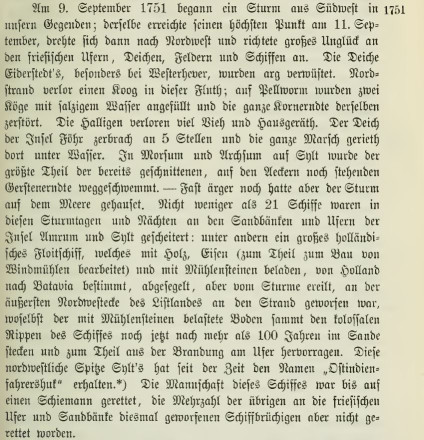History
The Amstelland was an East India man of the flute type, built for the Chamber of Amsterdam of the Dutch East India Company (VOC). She departed on 7 September 1751 from Texel on a voyage to Batavia, but a gale drove her off course to the east on 18 September and she ran ashore on the island of Sylt on the coast of Germany.
The ship was probably heading to Königshafen (literally: king’s haven), an anchorage near List, to seek shelter during the storm, but it ran aground at the north-westerly promontory of Sylt. This promontory became known as Ostindienfahrerhuk (literally: East India man's hook), a toponym still used today. According to a local chronicler (Christian Peter Hansen), the wreck was situated in the surf-zone and its massive frames were still visible in his time, a hundred years later. According to the chronicler, the wreck was laden with timber, mill-stones, and prefabricated iron fittings for windmills, but he made no mention of the cargo of silver bars, which must have been on board according to VOC records. Given the islanders’ fastidious dealings with the law and their disinclination to return the lawful share of salvaged goods to the owner, it would not be surprising if this was a well kept secret amongst the salvagers, as the silver did evidently not find its way into the island’s written record

Description
Yard: Amsterdam
Tonnage: 850 tons, 425 last
| Skipper | Hendriksz. Hoek, Hilde |
|---|---|
| People on board | 87 |
| Length | 136 Amsterdam feet (38.5 m) |
Status
According to - as yet - unconfirmed reports, the site was rediscovered by amateur wreck divers.
References
- Hansen, C. P. (1856).
Chronik der Friesischen Uthlande.
Altona: Lange. - 1.11.01.01.551 Lijst van alle zoodanige Schepen, fol. 7.
- Dutch-Asiatic Shipping.
Details of voyage 3530.1 from Texel.